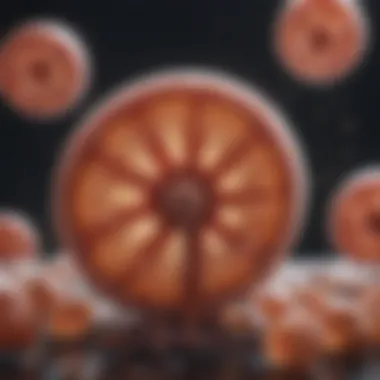Exploring the Link Between UTIs and Kidney Disease


Intro
Urinary tract infections (UTIs) and kidney disease are topics often brushed under the rug, yet their interconnection can spell serious health implications. Understanding this relationship is not just for medical professionals; it’s essential knowledge for anyone wishing to maintain their renal health. This article digs deep into how a simple infection can impact kidney function and illustrates the importance of timely responses to UTIs.
Research Overview
Summary of Key Findings
The literature suggests that recurrent UTIs can set off a chain reaction, ultimately leading to kidney damage. Several studies indicate that chronic inflammation resulting from UTIs may harm not only the bladder but also the kidneys. In these scenarios, the bacteria involved, often Escherichia coli, ascend from the urinary tract to the renal system, making early detection and management crucial. Another significant find is that people with pre-existing kidney conditions are far more vulnerable to developing UTIs, leading to a vicious cycle of disease.
Importance of the Research
Understanding the nexus between UTIs and kidney disease holds profound implications for preventative medicine and patient care. Acknowledging this connection enables healthcare professionals to take proactive measures in managing patients at risk. By acting swiftly, patients can avoid complications that could escalate to chronic kidney issues.
Methodology
Study Design
A mixed-methods approach was employed to comprehensively explore the link between UTIs and kidney disease. This involved both quantitative data from peer-reviewed studies and qualitative insights from patient surveys. Such a design helps in gaining a holistic understanding of how UTIs influence kidney health over time.
Data Collection Techniques
Data was gathered from multiple sources, including:
- Clinical trials that focus on patients with recurrent UTIs.
- Longitudinal studies tracking renal function in diverse populations.
- Surveys from affected individuals, shedding light on their health experiences and outcomes.
The synergy between urinary health and kidney function cannot be overstated; managing infections proactively is imperative in retaining overall health.
Professionals should become astute in spotting the signs of a UTI, which commonly include frequent urination, burning sensation, and cloudy urine. Additionally, understanding individual risk factors—like diabetes or previous infections—can shape effective preventive strategies.
By delving into these intertwined health issues, we can gain greater awareness of their implications, paving the way for informed decision-making and improved health outcomes.
Prolusion
The connection between urinary tract infections (UTIs) and kidney disease is a vital topic in medical discourse, yet many are still unaware of its significance. Understanding how these infections can escalate into serious kidney complications can be a turning point in managing both conditions effectively. UTIs, though often treatable, pose risks that can lead to long-term renal issues if left unattended. The objective of this section is to shed light on this relationship, emphasizing the necessity of timely intervention.
Overview of UTIs
UTIs are common infections that affect various parts of the urinary system, primarily the bladder and urethra. They can sometimes travel up to the kidneys, leading to much more severe conditions. The prevalence of UTIs is staggering; estimates suggest that millions experience one yearly. When one factors in recurrent UTIs, the numbers climb even higher. Common instigators include bacteria such as Escherichia coli, which is responsible for about eighty percent of cases. It’s critical to understand that what starts as an uncomfortable infection could set the stage for more serious health challenges.
Importance of Kidney Health
Kidneys play a crucial role in filtering waste and excess fluids from the body, making their well-being paramount. When these organs become compromised due to infections, the whole system can take a hit. Kidney disease can gradually escalate into irreversible damage, underscoring the need to prioritize kidney health from the get-go. Factors like dehydration, high blood pressure, and underlying conditions can influence kidney function, complicating the landscape further. Thus, being proactive in maintaining kidney health isn’t just sensible; it’s essential for overall well-being.
"Ignoring a UTI can ultimately harm the kidneys and lead to serious, lasting health issues."
With the right information and understanding, both healthcare professionals and those affected can navigate this delicate relationship between UTIs and kidney disease, ensuring appropriate measures are taken before it’s too late.
Understanding UTIs
Urinary tract infections (UTIs) stand as a significant health concern, particularly in relation to kidney disease. Understanding UTIs involves delving into their causes, symptoms, and treatment options, making it essential for both healthcare providers and patients alike. The intricacies of UTIs reveal much about their potential consequences on renal health, thereby highlighting their relevance in this article.
Etiology and Pathophysiology
The etiology of UTIs is primarily rooted in bacterial invasion, commonly from the gut flora, such as Escherichia coli. This bacterium travels to the urinary system, where it can take hold and lead to infection. Pathophysiologically, UTIs can cause inflammation of the urinary tract. If left unchecked, infections may ascend through the ureters to the kidneys, culminating in more severe complications such as pyelonephritis. This cascading effect underscores the need to recognize the early signs of a UTI and act promptly to prevent further damage, particularly to the kidneys.
Symptoms and Diagnosis
Recognizing the symptoms of a UTI is vital for timely diagnosis. Usual symptoms include frequent urination, strong urges to urinate, a burning sensation while urinating, cloudy or strong-smelling urine, and sometimes fever. Diagnosing a UTI typically involves a combination of urinalysis, urine culture, and, if indicated, imaging studies to check for abnormalities in the urinary tract. A swift and accurate diagnosis not only alleviates discomfort but also serves to protect kidney function, making education on UTI symptoms imperative.
Types of UTIs
UTIs can be categorized based on their location and severity; understanding these differences is crucial.
Cystitis
Cystitis refers to the inflammation of the bladder, often resulting from a lower urinary tract infection. Its primary symptom is dysuria—painful urination. Cystitis, while uncomfortable, is generally manageable and well-documented in terms of treatment options. It tends to be a relatively common presentation of a UTI. However, if not treated properly, it can transform into a more severe infection affecting the kidneys. Therefore, timely treatment of cystitis can prevent escalation into more serious health issues.
Pyelonephritis
Pyelonephritis is a severe kidney infection that can develop when a UTI spreads upward from the bladder. Key indicators of this condition include high fever, chills, and abdominal pain. Given its potential severity, understanding pyelonephritis is crucial due to its implications for kidney health. It stands out because it requires more aggressive treatment measures often including hospitalization and intravenous antibiotics. Failure to treat pyelonephritis swiftly can lead to permanent kidney damage or sepsis, which could jeopardize overall health.


Asymptomatic Bacteriuria
Asymptomatic bacteriuria, as the name suggests, involves the presence of bacteria in the urine without any symptoms of UTI. Despite the lack of symptoms, this condition holds its own significance, particularly in populations like pregnant women or diabetic patients, who may experience complications if not adequately addressed. The key feature of asymptomatic bacteriuria is the potential risk it poses; it may lead to symptomatic infections if not monitored judiciously. Awareness of this condition can lead to timely interventions, helping to maintain kidney function.
In essence, understanding these types of UTIs enhances our knowledge of their complexities and the necessity for timely management. Each type offers unique characteristics that underscore the broad impact UTIs have on kidney health, outlining an urgent need for effective prevention and treatment strategies.
Kidney Disease Background
Kidney disease is a crucial aspect to examine in relation to urinary tract infections (UTIs) as it highlights the interplay between these two health issues. Knowing this connection not only helps clinicians manage patients better but also serves to educate those affected by either condition. This section delves into the different types of kidney diseases, their unique characteristics and implications, and the factors that contribute to these diseases.
Types of Kidney Disease
Acute Kidney Injury
Acute Kidney Injury (AKI) is marked by a sudden decline in kidney function. This condition can develop rapidly, over a few hours or days, and often results from events like severe dehydration, infections, or exposure to certain drugs. The key characteristic of AKI is its reversibility; with timely intervention, kidney function can be restored. This feature makes AKI particularly relevant in discussions about UTIs, as untreated UTIs can lead to kidney infections, drastically increasing the risk for developing AKI.
Unique feature of AKI includes its transient nature; while it can be serious, it often answers well to treatment and recovery is possible. However, there is a disadvantage to this temporary aspect, as previous episodes of AKI can predispose individuals to chronic issues later on. Thus, recognizing AKI prompts health professionals to be vigilant, especially when they suspect infections.
Chronic Kidney Disease
Chronic Kidney Disease (CKD) develops gradually over a long period. One key aspect to note about CKD is it can stem from chronic conditions like diabetes or high blood pressure. This disease is particularly concerning because it may not show clear, noticeable symptoms until the kidney function is severely impaired. The chronic nature of this disease means that the health of the kidneys continues to decline, necessitating careful monitoring and interventions.
The significant characteristic of CKD is its impact on a person’s overall health over time. The chronic aspect requires long-term management strategies which could also integrate UTI prevention efforts. Understanding how UTIs can complicate CKD is essential. For example, occurs when an infection exacerbates the already declining kidney function, leading to further complications. CKD’s unique feature is its gradual progression that often leads to End-Stage Renal Disease if left untreated, which brings us to the next significant point.
End-Stage Renal Disease
End-Stage Renal Disease (ESRD) is the final stage of chronic kidney disease and requires dialysis or a kidney transplant for survival. Understanding ESRD is critical in this context because it can stem from untreated kidney issues, including complications arising from UTIs. The key characteristic here is not just the level of kidney function—that it is insufficient to maintain bodily fluid and electrolyte balance—but also the life-altering choices patients must make, such as deciding on dialysis.
A unique feature of ESRD is its irreversible nature; once a person reaches this stage, the kidneys can no longer function adequately. The advantages of discussing ESRD in relation to UTIs lie in the urgency of prevention and the need for early intervention.
How a UTI might perpetuate kidney decline, leading to potentially irreversible damage characterizes the importance of recognizing kidney disease and its associations right from the outset.
Causes and Risk Factors
Identifying the causes and risk factors of kidney disease is vital as it offers insights into prevention strategies that can significantly help patients manage their overall health. Risk factors might encompass a broad range of genetic, lifestyle, and environmental elements. For instance, individuals with diabetes or hypertension are at increased risk for developing chronic kidney disease, emphasizing the need for routine screenings and proactive health management. Moreover, recurrent UTIs serve as another potential risk factor for kidney complications.
Linking UTIs to Kidney Health
Understanding the connection between urinary tract infections (UTIs) and kidney health is pivotal for both healthcare providers and individuals. UTIs, though often perceived as common and manageable, can have far-reaching implications for kidney function. The kidneys are essential organs responsible for filtering blood and eliminating waste. If an infection spreads from the urinary tract to the kidneys, it can not only exacerbate existing issues but also lead to new complications that jeopardize renal health.
The cascading effects of untreated UTIs can lead to a range of kidney problems, making it essential to grasp the underlying mechanisms at play. Failure to address UTIs promptly raises the risk of progression to more severe kidney disease, emphasizing the paramount importance of awareness and preventative measures.
Mechanisms of Kidney Damage from UTIs
Infection Ascension
Infection ascension refers to the journey of bacteria moving upward from the bladder to the kidneys. This upward migration typically occurs when a UTI is left untreated. The key characteristic of this process is how swiftly it can escalate kidney health issues, transforming a simple UTI into a serious kidney infection like pyelonephritis.
This aspect is significant for our discussion as it illustrates how critical timely intervention can be. If bacteria reach the kidneys, they can cause inflammation and damage, directly impacting kidney functionality. A unique feature of infection ascension is its potential for quick progression; if untreated, what starts as a mild infection can rapidly turn into renal distress, affecting kidney filtering capacity.
The advantage of understanding this mechanism is the emphasis it places on early diagnosis and treatment. Recognizing the signs of a UTI can play a decisive role in preventing severe complications.
Inflammatory Responses
Inflammatory responses triggered by UTIs pose a substantial risk to kidney health. When the body senses an infection, it mounts a defense, which includes increased blood flow and white blood cell activity in the affected area. The key characteristic of this inflammation is its dual nature—it is a necessary protective response, but when excessive, can cause more harm than good.
Notably, the inflammatory responses can lead to tissue damage in the kidneys, especially in cases of severe or prolonged infection. This insight is beneficial for this article as it underscores the need for rapid management ofUTIs, ideally before such complications can arise.
The disadvantage here may lie in the body's sometimes excessive response to infection; even a minor UTI can spur a significant inflammatory reaction that may harm kidney tissues more than the original infection.
Structural Changes
Structural changes in kidney tissues can occur due to ongoing UTIs or repeated infections. These changes can manifest as scarring, which in turn may impair the kidneys’ ability to function effectively. The key characteristic of structural changes is their potential permanence—unlike some symptoms that might resolve with treatment, tissue damage might linger long after the infection has subsided.
Within our context, this element serves to remind us that kidney health is not only about managing current infections but also about preventing long-term damage. One notable feature of these structural changes is that they may silently accumulate; individuals might feel fine while their kidney function deteriorates over time, underscoring the importance of regular medical check-ups.
Drawbacks include the possibility that patients may not seek treatment for recurrent UTIs until they experience significant symptoms, by which time irreversible changes might have already occurred.
Epidemiological Studies
Epidemiological studies have strengthened our understanding of the connection between UTIs and kidney disease. Research has shown a notable correlation between recurrent UTIs and an increased risk of kidney damage, particularly in vulnerable populations such as women and the elderly. These studies aid in establishing preventive measures and effective treatment protocols while reaffirming the critical nature of addressing UTIs before they evolve into more serious health issues.
Diagnosis and Treatment


In the scope of urinary tract infections (UTIs) that might lead to complications such as kidney disease, diagnosing and treating them appropriately assume a pivotal role. Quick and accurate diagnosis is essential to prevent further adversities in renal health. Treatment strategies not only aim to eliminate the infection but also consider the overall management of kidney health. The interconnectedness of UTIs and kidney function underscores the need for both healthcare professionals and patients to understand and engage in effective diagnosis and treatment options.
Diagnostic Approaches for UTIs
Urinalysis
Urinalysis is a cornerstone of diagnosing UTIs. This test evaluates the physical, chemical, and microscopic properties of urine. It's widely regarded due to its simplicity and ability to provide immediate results, making it a first-line approach. A significant feature of urinalysis is its capacity to detect the presence of nitrites, which can indicate bacterial activity, along with the observation of white blood cells that suggest inflammation.
- Benefits: Quick results and minimal invasiveness.
- Drawbacks: False positives can occur, and it may not definitively pinpoint the specific pathogen involved in the infection.
Imaging Studies
Imaging studies encompass various techniques, such as ultrasound or CT scans, aimed at visualizing the kidneys and urinary tract. These studies are particularly beneficial when complications are suspected. A critical characteristic of imaging is its ability to detect anomalies like obstructions or structural abnormalities that might predispose one to recurrent UTIs.
- Benefits: Provides detailed anatomical insights.
- Drawbacks: Potential exposure to radiation (in the case of CT) and possible discomfort for the patient during procedures.
Culture Tests
Culture tests involve growing bacteria from urine samples, allowing for the identification of the specific infectious agent. This method is invaluable for determining the most effective antibiotic treatment. A unique feature of culture tests is their ability to reveal antibiotic sensitivities, helping tailor therapy to combat resistance effectively.
- Benefits: Specific pathogen identification and tailored antibiotic selection.
- Drawbacks: It may take longer for results to return, delaying treatment decision making.
Managing UTIs Effectively
Antibiotic Therapy
Antibiotic therapy is often the first line of treatment for confirmed UTIs. The goal is to eradicate the offending bacteria swiftly. One key advantage of antibiotic therapy is its widespread familiarity among healthcare providers who can make rapid prescribing decisions. However, resistance patterns are an ongoing concern.
- Benefits: Generally effective in resolving infections.
- Drawbacks: Risk of developing antibiotic-resistant bacteria if overused.
Empirical Treatment
Empirical treatment refers to starting antibiotics based on clinical judgment before cultures are read. This is particularly useful during acute presentations where waiting for lab results could worsen the patient’s condition. A distinctive aspect of this approach is the reliance on established guidelines and local resistance patterns.
- Benefits: Faster initiation of treatment can lead to better outcomes.
- Drawbacks: May not be effective if the chosen antibiotic does not target the specific strain of bacteria causing the infection.
Addressing Resistance
As concerns over antibiotic resistance grow, addressing it becomes paramount. Developing strategies to minimize resistance, such as using targeted therapies based on culture results, is crucial. A notable characteristic of addressing resistance is its multifaceted approach, involving not only medication management but also educational initiatives for both patients and healthcare providers.
- Benefits: Reduces future complications and preserves the efficacy of current treatment options.
- Drawbacks: Requires ongoing research and potentially changes in practice, which might take time to implement.
Kidney-Specific Treatment Options
Hydration Strategies
Maintaining adequate hydration is vital for kidney health, particularly for those dealing with frequent UTIs. Increased fluid intake helps flush out harmful bacteria from the urinary system. A key characteristic of this strategy is its accessibility and simplicity, making it a common recommendation alongside other treatments.
- Benefits: Supports renal function and helps clear infections more effectively.
- Drawbacks: In some cases, excessive fluid intake can lead to discomfort or strain on the kidneys, especially in individuals with pre-existing kidney issues.
Nutritional Considerations
Nutrition plays a vital role in supporting kidney health and recovery from infections. A well-balanced diet can bolster the immune system and promote healing. The unique feature of focusing on nutritional considerations is the potential to tailor dietary choices based on the specific needs of individuals based on their medical history and kidney function.
- Benefits: Enhances overall well-being and may reduce recurrence of UTIs.
- Drawbacks: Requires nutritional guidance to implement effectively, and may not be feasible for all individuals, especially those with dietary restrictions.
Preventive Strategies
In exploring the intricate relationship between urinary tract infections (UTIs) and kidney disease, preventive strategies emerge as a critical focal point. Implementing effective strategies can substantially lower the risk of UTIs and, consequently, protect kidney health. These methods not only mitigate the occurrence of infections but also promote a holistic approach to maintaining well-being. Understanding these strategies is crucial for both healthcare providers and individuals looking to safeguard their renal function.
Lifestyle Modifications
Lifestyle changes form the bedrock of prevention. These modifications are relatively easy to adopt and can lead to significant health benefits.
Hygiene Practices
Focusing on hygiene practices reveals how simple yet effective personal care routines contribute to preventing UTIs. Regularly washing the genital area with mild soap and water helps in minimizing the presence of bacteria. Notably, wiping from front to back after using the restroom reduces the risk of bowel bacteria reaching the urethra. This practice is a beneficial choice because it is straightforward and doesn't require special tools or materials.
However, certain soaps or products can irritate these sensitive areas, which is a potential disadvantage to keep in mind. A gentle approach is best, emphasizing the use of unscented products.
Fluid Intake Recommendations


Fluid intake is another key player in the prevention game. Keeping oneself adequately hydrated aids the urinary system in flushing out bacteria, diminishing the likelihood of infections. Water is the best choice because it's free of calories and does not irritate the bladder. This makes it a popular and beneficial option in preventing UTIs. The unique aspect of this recommendation is its simplicity: drinking more water can be easily integrated into daily habits.
But some individuals may face challenges, such as frequent trips to the restroom, causing inconvenience. Balancing hydration with daily activities is essential for maintaining overall health while preventing infections.
Role of Medications
In some cases, medications can serve as an adjunctive measure to prevent UTIs, particularly in those with recurrent infections. The consideration of medication prompts a deeper exploration of two specific areas: prophylactic antibiotics and alternative therapies.
Prophylactic Antibiotics
Prophylactic antibiotics can offer a preventive layer for those prone to frequent UTIs. These medications can help manage the bacterial levels in the urinary tract, reducing occurrences significantly. This option is recognized as beneficial for individuals with a history of recurrent infections, making it a common recommendation by healthcare practitioners.
On the flip side, the use of antibiotics carries its own unique feature: the risk of developing antibiotic resistance. Overusing these medications may diminish their effectiveness over time, which poses a challenge that needs thoughtful consideration.
Alternative Therapies
Considering alternative therapies expands the toolkit for prevention. These options often include herbal remedies, probiotics, or dietary adjustments. For instance, cranberry supplements have garnered attention for their potential role in reducing UTI frequency. This emphasizes an important characteristic of alternative therapies—they often focus on natural healing as an adjunct to traditional medicine, aligning with a more holistic view of health.
That said, while some individuals might find success with these methods, the scientific backing can be limited or inconsistent. Therefore, it’s critical that individuals consult medical professionals before embracing any alternative approach.
In summary, preventive strategies that encompass lifestyle modifications and medication options form an essential part of a comprehensive approach to managing the connection between UTIs and kidney health. By integrating these practices into daily life, individuals can empower themselves against infections, safeguarding their kidneys for the long haul.
Implications of Untreated UTIs
When urinary tract infections are left unchecked, the potential for significant adverse effects escalates, particularly concerning kidney health. This section delves into how neglecting these infections not only diminishes renal function but can also provoke broader health consequences.
Impact on Kidney Function
The kidneys play a central role in filtering waste from the blood and balancing essential fluids. An untreated UTI can morph from a trivial annoyance into a serious health threat. If bacteria managing to travel upward through the urinary tract, they can invade the kidneys, leading to complications like pyelonephritis.
This ascent could provoke inflammation, resulting in noticeable damage to kidney tissues. Over time, as renal function wanes from repeated infections, patients may face chronic kidney disease, or worse yet, end-stage renal disease. The risks magnify especially in individuals with pre-existing kidney issues or those who have experienced recurrent infections.
- Long-term Effects on Filtering Ability: The renal filtering process can become compromised, leading to higher levels of toxins in the bloodstream.
- Potential for Scarring: Recurrent untreated infections can precipitate scarring of renal tissues, permanently impairing kidney function.
"Ignoring a UTI is like ignoring a slow leak in your house; it may seem minor at first, but left unattended, it can lead to far worse damage."
Consequences for Overall Health
The ramifications of untreated urinary tract infections extend beyond the kidneys. Systemic effects may arise, manifesting in different forms across the body. Those with persistent infections could experience a cascade of health issues, impacting their daily lives and overall wellbeing.
Some of these consequences include:
- Increased Risk of Sepsis: Bacteria entering the bloodstream can elicit a severe immune response, leading to sepsis, a potentially life-threatening condition.
- Chronic Pain and Discomfort: Frequent infections can result in recurrent pain or discomfort in the bladder, kidneys, or lower abdomen.
- Disruptions in Daily Life: The ongoing physical distress might limit activities and affect mental health, leading to anxiety and stress.
- Impeded Sexual Health: For some, untreated UTIs can interfere with sexual function and desire, creating additional challenges.
In short, untreated UTIs present a serious concern, intertwining kidney health with overall physical compromise. Addressing UTIs in their initial stages is key to halting this spiral into broader health challenges.
Future Directions in Research
In the ever-evolving landscape of medicine, understanding the connection between urinary tract infections (UTIs) and kidney disease is crucial. Future research holds significant promise for improving outcomes in individuals affected by these conditions. Developing insights into the intricate dynamics of UTIs helps inform treatment strategies and ultimately enhances patient care. As scientists dive deeper into this relationship, numerous aspects stand out that warrant close examination.
Emerging Treatment Modalities
One of the most compelling areas of focus is the exploration of emerging treatment modalities. Current standard practices often revolve around antibiotics, yet they encounter ebbs and flows of efficacy due to antibiotic resistance. Therefore, researchers are investigating alternative therapies.
- Phage Therapy - This involves using bacteriophages, viruses that specifically target bacteria. Initial findings suggest that phage therapy could reduce UTI incidence while minimizing the risk of antibiotic resistance.
- Immunotherapy - By boosting the immune system’s response, therapies could potentially prevent recurrent UTIs that, unchecked, may lead to kidney complications.
- Biofilm Disruption Agents - Many bacteria form biofilms, making them resistant to treatment. New research into substances that can break these down could enhance treatment efficacy.
"Innovative strategies are not just the future; they're the present solution to an escalating problem."
Understanding Long-term Effects
Another essential facet regards understanding the long-term effects of UTIs on kidney health. Chronic UTIs, if not managed properly, can lead to lasting renal damage. Researchers emphasize the necessity of long-term studies to track the progression of kidney disease stemming from recurrent UTIs.
- Chronic Inflammation: Continuous infection may provoke persistent inflammation, contributing to kidney dysfunction over time. Understanding this process can open new therapeutic avenues.
- Scarring and Structural Changes: It's important to study the patterns of scarring within the kidneys resulting from ongoing infections. Insights here may lead to improved imaging techniques or preventive measures.
- Quality of Life Assessments: Beyond the physical toll, evaluating the psychosocial impact on those enduring chronic UTIs may guide holistic treatment approaches.
Closure
The connection between urinary tract infections (UTIs) and kidney disease is both complex and critical. Understanding this relationship not only sheds light on the mechanisms of disease but also emphasizes the importance of early diagnosis and treatment of UTIs to protect renal health. In this article, we've explored various aspects of UTIs, from their etiology to their potential consequences on kidney function.
Summary of Key Points
- Prevalence and Impact: UTIs are common health issues, particularly among women, and can escalate to serious conditions affecting the kidneys if left untreated.
- Mechanisms of Damage: The pathways through which UTIs can lead to kidney damage include infection ascension, inflammatory responses, and structural changes that compromise kidney function.
- Public Health Considerations: Addressing UTIs promptly through effective diagnostic and therapeutic strategies can prevent significant long-term health complications, including chronic kidney disease.
- Preventive Measures: Simple lifestyle modifications and timely medical interventions can make a world of difference in maintaining kidney health.
The Urgency of Addressing UTIs
There’s a pressing need to recognize and tackle UTIs as potential precursors to kidney complications. Alarmingly, untreated UTIs can lead to serious conditions, such as cystitis and pyelonephritis, both of which can severely impact overall kidney function if not managed properly. The key lies in awareness and education—helping individuals identify symptoms early on can significantly reduce the risk of these complications. As the old saying goes, "an ounce of prevention is worth a pound of cure."
Healthcare providers play a pivotal role in this by ensuring patients understand the importance of seeking medical advice when symptoms arise. Comprehensive education on maintaining urinary health is essential—not just for patients but also for healthcare professionals who often are the first line of defense in managing these infections.
In summary, the urgency of addressing UTIs cannot be overstated. Early intervention is not just beneficial; it is imperative. The ongoing discourse around UTIs and kidney health needs more attention to ensure patients are well-informed and equipped to make decisions that prioritize their well-being. This article sheds light on a critical area of health that warrants further exploration and action.



